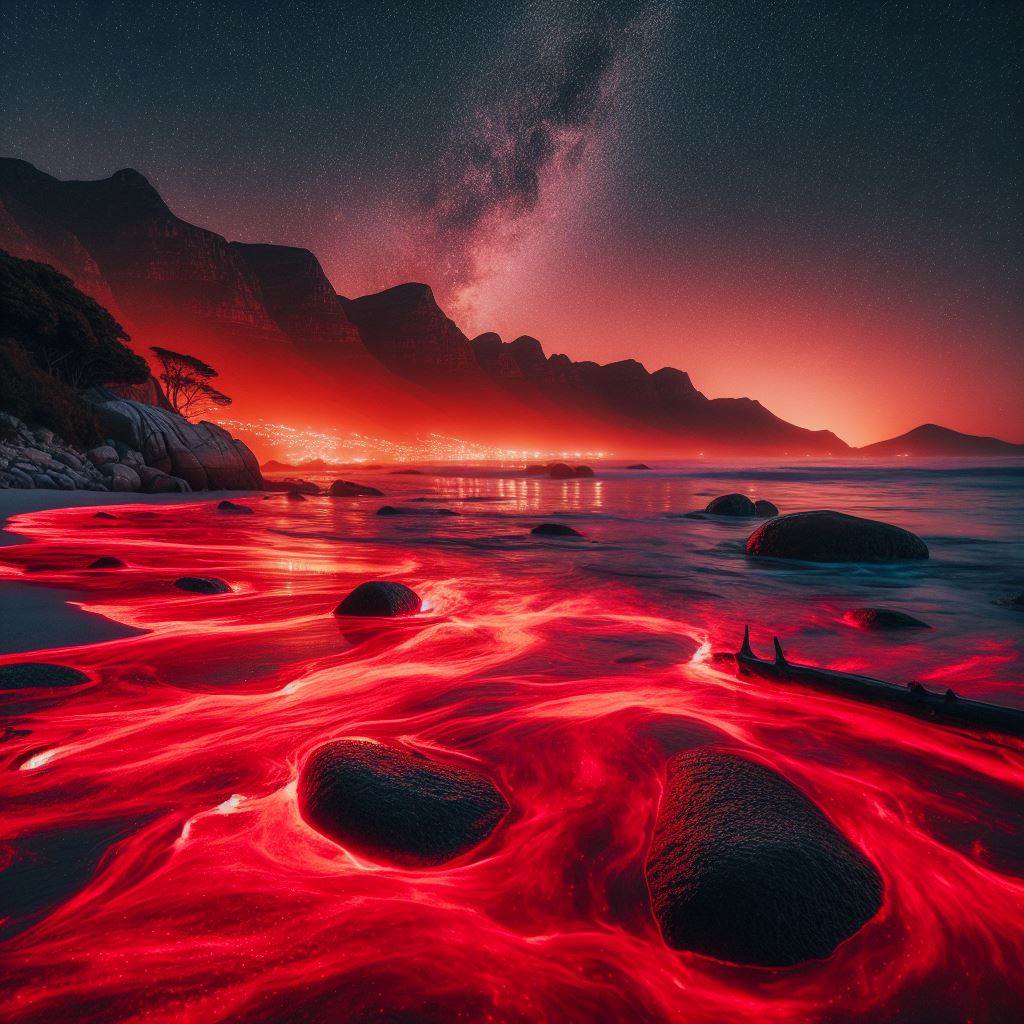
Red tides are mainly caused by Sewage
Red tides are mainly caused by Sewage: Sewage = nutrients. Nutrients + warm temperatures = exponential growth of biomass. A red tide is known scientifically as an HAB, or Harmful Algae Bloom. Red tides have also occurred in the wild where no human sewage occurs. But this red tide we are referring to, is the one that makes the ocean glow at night. That we see in and around Cape Town often. Especially recently, in False Bay. And allegedly even in Durban.
Tourists love the glowing waves at night time!
HAB
A broad definition of HABs was adopted by the US Environmental Protection Agency in 2008 who stated that HABs include “potentially toxic (auxotrophic – the inability of an organism to synthesize a particular organic compound required for its growth, heterotrophic – an organism that cannot produce its own food, instead taking nutrition from other sources of organic carbon, mainly plant or animal matter) species and high-biomass producers that can cause hypoxia (deficiency in the amount of oxygen reaching the tissues) and anoxia (an absence or deficiency of oxygen reaching the tissues) and indiscriminate mortalities of marine life after reaching dense concentrations, whether or not toxins are produced”.[1]
Harmful algal blooms in coastal areas are also often referred to as “red tides”.[12] The term “red tide” is derived from blooms of any of several species of dinoflagellate, such as Karenia brevis.[13] However, the term is misleading since algal blooms can widely vary in colour, and the growth of algae is unrelated to the tides. Not all red tides are produced by dinoflagellates. The mixotrophic ciliate Mesodinium rubrum produces non-toxic blooms coloured deep red by chloroplasts it obtains from the algae it eats.?[14]
As a technical term, it is being replaced in favour of more precise terminology, including the generic term “harmful algal bloom” for harmful species, and “algal bloom” for benign species
Biomass floats so winds and currents play the role of moving it all around.
Karenia
Karenia brevis, a microscopic, single-celled, photosynthetic organism, is indeed found in our coastal waters. However, it is not commonly found in South Africa. Instead, it is primarily associated with the Gulf of Mexico.

In South Africa, we have our very own Karenia species that have been identified. For instance, Karenia cristata and Karenia bicuneiformis were discovered off the South African coast. These species turned the waters of False Bay into a murky olive-green colour in the late 1980s. They caused adverse effects such as abalone mortalities and irritations in humans.
So, while Karenia brevis is not prevalent in South Africa, the country hosts its very own unique Karenia species. Possibly even indigenous or endemic. Nature’s diversity never ceases to surprise!
Karenia brevis is the most studied and the one we can learn from.
Poison payload
Karenia brevis is a harmful single-cell organism that consumes all the oxygen from the water as they process the influx of raw untreated sewerage. Brevetoxins are their payload. Among some other algae growth inhibitors. The brevotoxins are what affect the shellfish. And the reason you should not eat shellfish that was caught or killed in a red tide, ever.
Symptoms of neuro-toxic shellfish poisoning
Neurotoxic shellfish poisoning (NSP) (Landsberg, 2002). NSP is characterized by acute gastrointestinal and neurological symptoms, including nausea, vomiting, diarrhoea, chills, sweats, headache, muscle weakness and joint pain, paraesthesia, arrhythmias, difficulty breathing, mydriasis, double vision, and troubles in talking and swallowing. Recovery occurs in 2 or 3 days, and no fatal cases from NSP have been reported (Baden and Adams, 2000; Hallegraeff, 2003; Isbister and Kiernan, 2005).
So yes, rather leave them shells alone during and immediately after a red tide.
Affiliated YouTube Channels
https://youtube.com/@thesardinenews
https://youtube.com/@mydotackletalk
https://youtube.com/@waterwoes
https://youtube.com/@Brucifire
Websites
https://brucifire.co.za
https://thesardine.co.za
https://masterwatermen.co.za
https://umzimkuluadrenalin.co.za
https://divingdivassa.co.za
